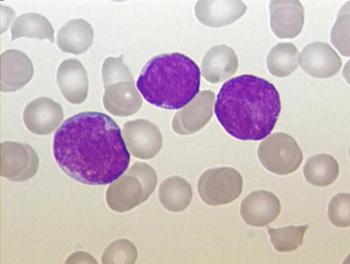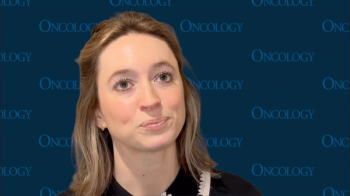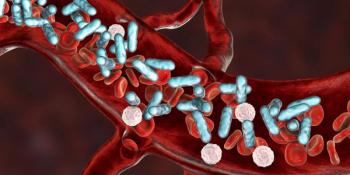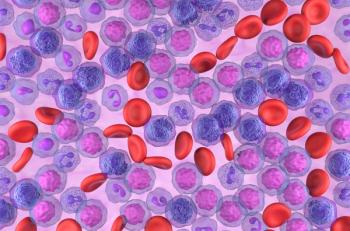
Risk of AML in Thyroid Cancer Patients Treated With Radioactive Iodine
In this interview we discuss a study that examined the risk of acute myeloid leukemia in thyroid cancer patients who have been treated with surgery and radioiodine therapy vs those treated with surgery alone.
Today we are speaking with Sudipto Mukherjee, MD, MPH, a medical oncologist at the Cleveland Clinic in Ohio, about a study (abstract 960) he and his colleagues presented earlier this year at the 2017 European Society for Medical Oncology (ESMO) Congress on the risk of acute myeloid leukemia (AML) in patients with thyroid cancer who had been treated with radioiodine therapy.
-Interviewed by Anna Azvolinsky
Cancer Network: What do we know about the risk of leukemia in patients who are treated with radiation therapy such as radioactive iodine? In general, is the risk increased for all types of radiation exposure?
Dr. Mukherjee: It is well known that ionizing radiation is a carcinogen, and actually there is a growing body of evidence that shows that there is increased risk of leukemia following exposure to ionizing radiation-you can see that in different settings. Environmental exposure to ionizing radiation such as in Japanese atomic bomb survivors from Hiroshima and Nagasaki, people exposed to the nuclear fallout during the Chernobyl nuclear accident, and nuclear factory workers all have a higher risk of leukemia because of the exposure to radiation.
We can see a similar increased risk in cancer patients who have been treated with radiation in therapeutic settings, such as those with breast, gynecological, and prostate cancers, patients with Hodgkin and non-Hodgkin lymphoma. Particularly we see that the risk is higher when they have been exposed to external radiation alone or in combination with chemotherapy. There is data now showing that there is an increased risk of leukemia in patients who are exposed to radiation through diagnostic imaging modalities like CT scans, so the evidence linking radiation exposure to leukemia is there.
Generally the risk appears to be higher with the higher total dose or volume of radiation a person is exposed to. There are several other factors that can modify or increase the risk of leukemia in cancer patients. This could be whether the radiation was given alone, or if it was given in combination with chemotherapy-particularly with certain classes of chemotherapy drugs such as alkylating agents or topoisomerase inhibitors. It also depends upon the total cumulative dose of chemotherapy the particular cancer patient has received. It also depends on the type of the radiation, whether it’s external-beam radiation where the risk is high; total-body radiation where patients go as part of a conditioning regimen prior to a bone marrow transplant; very focused stereotactic radiation in the form of intracavity radiation; or brachytherapy like radioisotope seeds that are used for treating prostate cancer patients.
As you can see it all depends, and radiation exposure does not work in isolation. It does increase the risk, but it can also be modified or increased depending on what the other factors-clinical or disease- or treatment-related-that the patient has experienced to date.
Cancer Network: Could you tell us about the study you and your colleagues conducted where you looked specifically at the risk of AML in thyroid cancer patients treated with radioactive iodine?
Dr. Mukherjee: We were interested in finding out the risk of AML in thyroid cancer patients for one reason. That is, radioactive iodine is a very different type of radiation-compared with someone who gets external radiation-in the sense that well-differentiated thyroid cancer patients ingest radioactive iodine, and it is absorbed into the bloodstream. Now you have a patient whose bone marrow stem cells can be exposed to radioactive iodine for a long period of time simply because of certain pharmacokinetics.
The effective clearance half-time of radioactive iodine in a thyroid cancer patient is approximately 16 hours. You can imagine during that time the radioactive iodine is going through several cycles of whole-body circulation, and we think that that time is sufficient for the radiation (the circulating iodine) to cause injury to the bone marrow stem cells for them to transform into leukemia cells. This was a very interesting hypothesis, and we wanted to dig deeper into this and find out if this can cause an increased risk of leukemia.
The other reason why we chose thyroid cancer patients is because of a couple of disease-related factors that do make a difference. Acute leukemias are rare blood cancers, so if you want to do a study looking at acute leukemias, you want to find a patient population that is relatively young that has been treated with radiation alone, preferably, and can survive longer to allow these leukemias to happen. Well-differentiated thyroid cancer patients actually met all of that criteria. They are relatively young at the time of diagnosis (in their 40s), most of them are treated with either surgery or surgery followed by radiation-so they have a pretty homogenous radiation exposure-and the majority of them are long-term survivors, with more than 90% are alive beyond 10 years. This provides a perfect epidemiology setting to do a study like this, and that is the reason we studied these patients.
Cancer Network: Can you talk about the details and findings of the study?
Dr. Mukherjee: This was a registry, population-based study, so we had about 148,000 well-differentiated thyroid cancer patients from 1973 to 2014 whom we extracted from the a US national cancer registry-Surveillance, Epidemiology, and End Results (SEER). Of these patients 55% were treated with surgery alone, and 45% additionally required radioactive iodine following surgery. The median follow-up of these patients was roughly 4.5 years.
What we found was that in the group that were treated with surgery alone there were 45 cases of AML, but in the group that received both surgery and radiation, we found about 59 cases. We tried to assess the dynamic changes in the risk of leukemias in both of these differently treated thyroid cancer patients. The way that we did that is we looked at the change of leukemia with time, and we also compared the risk in these thyroid cancer groups to US population rates of leukemia, which we considered the background AML rate.
Our observations are pretty striking. What we found is that compared to the background AML rates in the US population, in thyroid cancer patients treated with surgery and radioactive iodine there was an early rise in the risk of AML that peaked in the second year following treatment. The risk of AML was 7.1-times greater in thyroid cancer patients treated with surgery and radiation compared to the background US population rates. Interestingly, beyond 2 years following exposure to the radioactive iodine, the risk of AML started to decline, and it kind of reached a population-level rate by 6 years. The take home message that we got is that in thyroid cancer patients who received both surgery and radiation, there is a high risk of leukemia (a 7.1-times relative risk) compared to the US population risk, and the risk is early-as early as 2 years following treatment.
The next step we looked at was, in these thyroid cancer patients who develop leukemia, does it affect their overall survival? We found that irrespective of the type of treatment they received-either surgery alone or surgery followed by radiation-thyroid cancer patients who did develop leukemia had shorter overall survival compared with those who did not develop leukemia. The difference was 8 years of survival for those who developed leukemia vs 31 years of survival in patients who did not develop leukemia, which was significant. Among the two groups-surgery alone vs surgery plus radiation-there was a trend of shorter survival in those who got radiation, but this did not reach statistical significance.
Cancer Network: What were some other interesting findings, and can you discuss which patients are typically receiving radioactive iodine, are these patients with more advanced disease?
Dr. Mukherjee: What we have seen in studying these cancer cohorts is that there has been a sharp rise in the use of radioactive iodine in the United States for the treatment of well-differentiated thyroid cancer patients. If you look at the data starting from 1973, patients treated with surgery followed by radioactive iodine increased from about 6.1% to almost 50% by 2006. If we analyze this a bit more, we find that a lot of these patients who received radioactive iodine had low- or intermediate-risk thyroid cancer. And for this group of patients, there is a questionable benefit of the use of radioactive iodine. Our worry is that a lot of patients, in the past, were unnecessarily treated with radioactive iodine.
Fortunately, since 2006 onward, we are seeing a decline in the use of radioactive iodine in low- and intermediate-risk cancer. This is consistent with the American Thyroid Association guideline. It, again, proves the point that radiation that is used for treating cancer is not a benign therapy, and should always be assessed in terms of a risk-to-benefit analysis. If the radiation treatment improves survival or disease-free survival, then of course the benefit outweighs the risk and justifies the use of radiation. But, in patients with low- or intermediate-risk thyroid cancer, where radioactive iodine is of questionable benefit, it might be better not to use these therapies. The patient may not get any benefit, and it definitely can put them at risk of developing leukemia later on.
Cancer Network: How will you and your colleagues use these study results? Is this study informing additional studies on risk of leukemia or does it provide a potential way forward, as you just mentioned, of differentiating treatment of thyroid cancer?
Dr. Mukherjee: That is actually a very important question. The results of our study clearly show that there is a growing population of thyroid cancer survivors in this country. A lot of them in the past, not currently, have been treated with radioactive iodine with basically no clear benefit from the therapy-so there is a large population of thyroid cancer survivors that are technically at risk of developing leukemia. When these patients are diagnosed with thyroid cancer, they are relatively young (in their mid 40s and 50s) and hopefully they do not have too many other existing medical conditions. Our message is that these patients should be closely monitored based on blood count and abnormalities. If you see something abnormal, it may be worthwhile to be aggressive with potentially diagnosing leukemia. If they are diagnosed with leukemia and are young and have few comorbidities, we can actually pursue a very aggressive strategy of bone marrow transplant, which is a potential cure.
So there are two take home messages. One is that the use of radioactive iodine in thyroid cancer patients should be done on the basis of a comprehensive benefit–risk analysis, preferably avoiding the use of radioactive iodine in low- or intermediate-risk patients who do not have sufficient criteria to justify the use of this therapy. And second, in patients who were already treated with radiation in the past, close follow-up and closer vigilance might be warranted because, when diagnosed early, we could potentially cure a lot of these cases through bone marrow transplant.
Cancer Network: Thank you so much for joining us today, Dr. Mukherjee.
Dr. Mukherjee: Thank you.Today we are speaking with Sudipto Mukherjee, MD, MPH, a medical oncologist at the Cleveland Clinic in Ohio, about a study (abstract 960) he and his colleagues presented earlier this year at the 2017 European Society for Medical Oncology (ESMO) Congress on the risk of acute myeloid leukemia (AML) in patients with thyroid cancer who had been treated with radioiodine therapy.
Cancer Network: What do we know about the risk of leukemia in patients who are treated with radiation therapy such as radioactive iodine? In general, is the risk increased for all types of radiation exposure?
Dr. Mukherjee: It is well known that ionizing radiation is a carcinogen, and actually there is a growing body of evidence that shows that there is increased risk of leukemia following exposure to ionizing radiation-you can see that in different settings. Environmental exposure to ionizing radiation such as in Japanese atomic bomb survivors from Hiroshima and Nagasaki, people exposed to the nuclear fallout during the Chernobyl nuclear accident, and nuclear factory workers all have a higher risk of leukemia because of the exposure to radiation.
We can see a similar increased risk in cancer patients who have been treated with radiation in therapeutic settings, such as those with breast, gynecological, and prostate cancers, patients with Hodgkin and non-Hodgkin lymphoma. Particularly we see that the risk is higher when they have been exposed to external radiation alone or in combination with chemotherapy. There is data now showing that there is an increased risk of leukemia in patients who are exposed to radiation through diagnostic imaging modalities like CT scans, so the evidence linking radiation exposure to leukemia is there.
Generally the risk appears to be higher with the higher total dose or volume of radiation a person is exposed to. There are several other factors that can modify or increase the risk of leukemia in cancer patients. This could be whether the radiation was given alone, or if it was given in combination with chemotherapy-particularly with certain classes of chemotherapy drugs such as alkylating agents or topoisomerase inhibitors. It also depends upon the total cumulative dose of chemotherapy the particular cancer patient has received. It also depends on the type of the radiation, whether it’s external-beam radiation where the risk is high; total-body radiation where patients go as part of a conditioning regimen prior to a bone marrow transplant; very focused stereotactic radiation in the form of intracavity radiation; or brachytherapy like radioisotope seeds that are used for treating prostate cancer patients.
As you can see it all depends, and radiation exposure does not work in isolation. It does increase the risk, but it can also be modified or increased depending on what the other factors-clinical or disease- or treatment-related-that the patient has experienced to date.
Cancer Network: Could you tell us about the study you and your colleagues conducted where you looked specifically at the risk of AML in thyroid cancer patients treated with radioactive iodine?
Dr. Mukherjee: We were interested in finding out the risk of AML in thyroid cancer patients for one reason. That is, radioactive iodine is a very different type of radiation-compared with someone who gets external radiation-in the sense that well-differentiated thyroid cancer patients ingest radioactive iodine, and it is absorbed into the bloodstream. Now you have a patient whose bone marrow stem cells can be exposed to radioactive iodine for a long period of time simply because of certain pharmacokinetics.
The effective clearance half-time of radioactive iodine in a thyroid cancer patient is approximately 16 hours. You can imagine during that time the radioactive iodine is going through several cycles of whole-body circulation, and we think that that time is sufficient for the radiation (the circulating iodine) to cause injury to the bone marrow stem cells for them to transform into leukemia cells. This was a very interesting hypothesis, and we wanted to dig deeper into this and find out if this can cause an increased risk of leukemia.
The other reason why we chose thyroid cancer patients is because of a couple of disease-related factors that do make a difference. Acute leukemias are rare blood cancers, so if you want to do a study looking at acute leukemias, you want to find a patient population that is relatively young that has been treated with radiation alone, preferably, and can survive longer to allow these leukemias to happen. Well-differentiated thyroid cancer patients actually met all of that criteria. They are relatively young at the time of diagnosis (in their 40s), most of them are treated with either surgery or surgery followed by radiation-so they have a pretty homogenous radiation exposure-and the majority of them are long-term survivors, with more than 90% are alive beyond 10 years. This provides a perfect epidemiology setting to do a study like this, and that is the reason we studied these patients.
Cancer Network: Can you talk about the details and findings of the study?
Dr. Mukherjee: This was a registry, population-based study, so we had about 148,000 well-differentiated thyroid cancer patients from 1973 to 2014 whom we extracted from the a US national cancer registry-Surveillance, Epidemiology, and End Results (SEER). Of these patients 55% were treated with surgery alone, and 45% additionally required radioactive iodine following surgery. The median follow-up of these patients was roughly 4.5 years.
What we found was that in the group that were treated with surgery alone there were 45 cases of AML, but in the group that received both surgery and radiation, we found about 59 cases. We tried to assess the dynamic changes in the risk of leukemias in both of these differently treated thyroid cancer patients. The way that we did that is we looked at the change of leukemia with time, and we also compared the risk in these thyroid cancer groups to US population rates of leukemia, which we considered the background AML rate.
Our observations are pretty striking. What we found is that compared to the background AML rates in the US population, in thyroid cancer patients treated with surgery and radioactive iodine there was an early rise in the risk of AML that peaked in the second year following treatment. The risk of AML was 7.1-times greater in thyroid cancer patients treated with surgery and radiation compared to the background US population rates. Interestingly, beyond 2 years following exposure to the radioactive iodine, the risk of AML started to decline, and it kind of reached a population-level rate by 6 years. The take home message that we got is that in thyroid cancer patients who received both surgery and radiation, there is a high risk of leukemia (a 7.1-times relative risk) compared to the US population risk, and the risk is early-as early as 2 years following treatment.
The next step we looked at was, in these thyroid cancer patients who develop leukemia, does it affect their overall survival? We found that irrespective of the type of treatment they received-either surgery alone or surgery followed by radiation-thyroid cancer patients who did develop leukemia had shorter overall survival compared with those who did not develop leukemia. The difference was 8 years of survival for those who developed leukemia vs 31 years of survival in patients who did not develop leukemia, which was significant. Among the two groups-surgery alone vs surgery plus radiation-there was a trend of shorter survival in those who got radiation, but this did not reach statistical significance.
Cancer Network: Can you discuss which patients are typically receiving the radioactive iodine, are these patients with more advanced disease?
Dr. Mukherjee: It does appear that what we have seen in studying these cancer cohorts is that there has been a sharp rise in the use of radioactive iodine in the U.S. in the treatment of well-differentiated thyroid cancer patients. And actually, if you look at the data between 1973 and 2006, the patients who are treated with surgery followed by radioactive iodine increased from about 6.1% to almost 50% in 2006. If we analyze this a bit more, what we find is that a lot of these patients who get radioactive iodine, they have low- or intermediate-risk thyroid cancer. And for this group of patients, there is a questionable benefit of the use of radioactive iodine. So our worry is that a lot of patients in the past unnecessarily treated with radioactive iodine especially in the setting evidence that we know of that radiation probably didn’t have much benefit. Fortunately, since 2006 onward, we are seeing a decline in the use of radioactive iodine in low and intermediate risk cancer. And this is consistent with the American Thyroid Association guideline. It, again, proves the point that radiation that is used for treating cancer is not a very benign therapy and should always be assessed in terms of a risk to benefit analysis. In the sense that if the radiation treatment improves survival or disease-free survival then of course, the benefit outweighs the risk and that justifies the use of radiation. But, in patients with thyroid cancer with low- or intermediate-risk disease where the risk of radioactive iodine is of questionable benefit, it might be better not to use these therapies because the patient may not get any benefit but it definitely can put them at the risk of developing leukemia later on.
Cancer Network: How will you and your colleagues use these study results? Is this study informing additional studies on risk of leukemia or does it provide a potential way forward, as you just mentioned, of differentiating treatment of thyroid cancer?
Dr. Mukherjee: That is, actually, a very important question in the sense that the results of our study clearly show that there are a growing population of thyroid cancer survivors in this country and a lot of them in the past, not currently, but in the past have been treated with radioactive iodine with basically, no clear benefit from the therapy so there is a large population of thyroid cancer survivors that are technically at risk of developing leukemia. When these patients are diagnosed with thyroid cancer, they are relatively young and hopefully, in their mid 40s and 50s they do not have too many other existing medical conditions. Our message is that these patients should be closely monitored and based on blood count and abnormalities, if you see something abnormal it may be worthwhile to be aggressive with potentially diagnosing leukemia in these patients because if they are diagnosed with leukemia, for those group of patients, especially since they are young and have few co-morbidities we can actually pursue a very aggressive strategy of a bone marrow transplant which is a potential cure.
So, two take home messages. One is that the use of radioactive iodine in thyroid cancer patients should be done on the basis on a comprehensive benefit-risk analysis, preferably avoiding the use of radioactive iodine in low or intermediate risk patients who do not have sufficient criteria to justify the use radioactive radiation. And second, in patients who were already treated with radiation in the past, up close follow up and closer vigilance might be warranted because these cases, when diagnosed early, we could potentially cure a lot of them through bone marrow transplant approaches.
Cancer Network: Thank you so much for joining us today, Dr. Mukherjee.
Dr. Mukherjee: Thank you.
Newsletter
Stay up to date on recent advances in the multidisciplinary approach to cancer.















































































